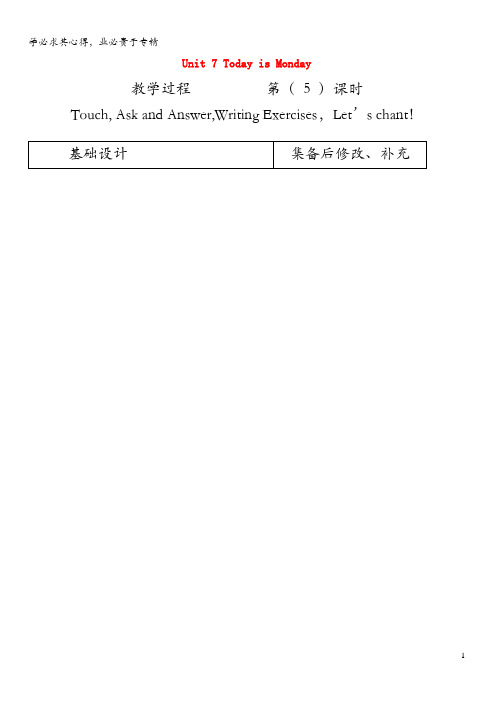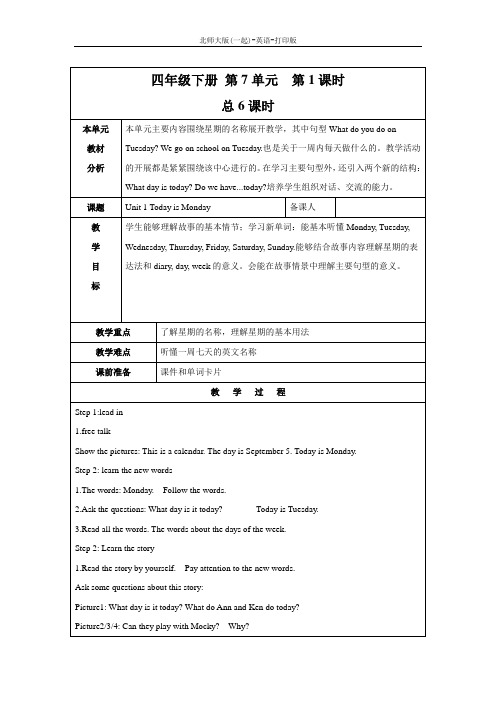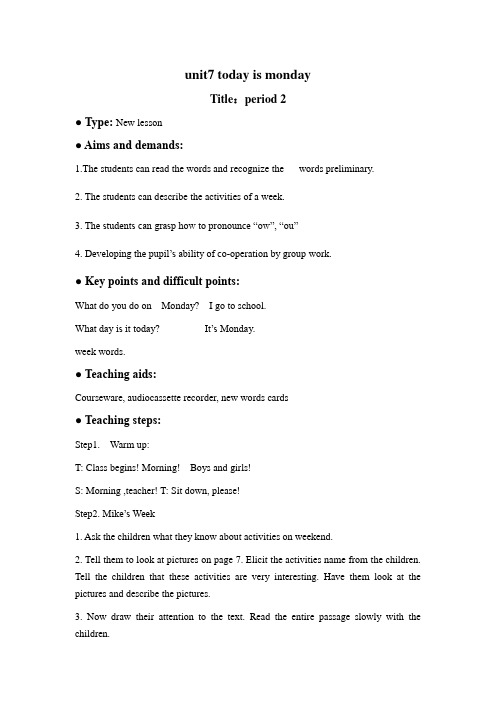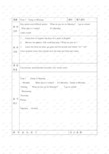北师大版四年级英语下册Unit7 Today is Monday 教案
- 格式:doc
- 大小:41.50 KB
- 文档页数:54




unit7 today is mondayTitle:period 2● Type: New lesson● Aims and demands:1.The students can read the words and recognize the words preliminary.2. The students can describe the activities of a week.3. The students can grasp how to pronounce “ow”, “ou”4. Developing the pupil’s ability of co-operation by group work.● Key points and difficult points:What do you do on Monday? I go to school.What day is it today? It’s Monday.week words.● Teaching aids:Courseware, audiocassette recorder, new words cards● Teaching steps:Step1. Warm up:T: Class begins! Morning! Boys and girls!S: Morning ,teacher! T: Sit down, please!Step2. Mike’s Week1. Ask the children what they know about activities on weekend.2. Tell them to look at pictures on page 7. Elicit the activities name from the children. Tell the children that these activities are very interesting. Have them look at the pictures and describe the pictures.3. Now draw their attention to the text. Read the entire passage slowly with the children.4. Read the text again. This time, read the first half of each sentence and have the children complete the rest. Alternatively you can ask simple questions to check their understanding.5. Tell the children that the pictures go together with the passage, and they need to put the pictures back into their positions. Read the second and third sentences. Ask the children which picture goes together with the sentences. Elicit the answer from the children. Have them write the answers on the correct place.6. Repeat the procedure with the other questions.7. Draw the children’s attention to the second activity. Read the sentences one by one. Have them choose the answer that best expresses their ideas. Practise the students’ listening And speaking. Ask the children to know the new languages of this unit and at the same time, consolidate the key point for thisunit. Consolidate the contents have learned.● Homework:Must do: 1. Read the new text 5 times at home.2. Translate the text into Chinese.3. Preview page 9-10.Choosing do: Read a new story by yourself.● Blackboard design:●课后反思:。

unit7 today is mondayTitle:period 2● Type: New lesson● Aims and demands:1.The students can read the words and recognize the words preliminary.2. The students can describe the activities of a week.3. The students can grasp how to pronounce “ow”, “ou”4. Developing the pupil’s ability of co-operation by group work.● Key points and difficult points:What do you do on Monday? I go to school.What day is it today? It’s Monday.week words.● Teaching aids:Courseware, audiocassette recorder, new words cards● Teaching steps:Step1. Warm up:T: Class begins! Morning! Boys and girls!S: Morning ,teacher! T: Sit down, please!Step2. Mike’s Week1. Ask the children what they know about activities on weekend.2. Tell them to look at pictures on page 7. Elicit the activities name from the children. Tell the children that these activities are very interesting. Have them look at the pictures and describe the pictures.3. Now draw their attention to the text. Read the entire passage slowly with the children.4. Read the text again. This time, read the first half of each sentence and have the children complete the rest. Alternatively you can ask simple questions to check their understanding.5. Tell the children that the pictures go together with the passage, and they need to put the pictures back into their positions. Read the second and third sentences. Ask the children which picture goes together with the sentences. Elicit the answer from the children. Have them write the answers on the correct place.6. Repeat the procedure with the other questions.7. Draw the children’s attention to the second activity. Read the sentences one by one. Have them choose the answer that best expresses their ideas. Practise the students’ listening And speaking. Ask the children to know the new languages of this unit and at the same time, consolidate the key point for thisunit. Consolidate the contents have learned.● Homework:Must do: 1. Read the new text 5 times at home.2. Translate the text into Chinese.3. Preview page 9-10.Choosing do: Read a new story by yourself.● Blackboard design:●课后反思:。

课题Unit-7 Today is Monday 课时第六课时教材分析Key points and difficult points: What do you do on Monday? I go to school. What day is it today? It’s Monday.week words.教学目标1. Learn how to express the days of a week in English2. Review the pattern: Can we/I/they play ? What do you do ?3. Learn the form do-does, go-goes and the sounds and letters “ou” “ow”4.Let students know they should save the time and help each other.课前准备Courseware, audiocassette recorder, new words cards板书设计Unit 7 Today is MondayMonday What day is it today? It’s Monday. / Today is Monday. Tuesday What do you do on Monday? I go to school. WednesdayThursdayFridaySaturday Sunday教学活动设计设计意图Step1. Warm up: T: Class begins!Morning! Boys and girls!S: Morning ,teacher!T: Sit down, please!Step 2. Ask and find out1. Copy the table onto the blackboard. write some week words (you can choose to use flashcard for this Unit) in the boxes. Pointing each week word, elicit the correct name from the children.2. Call a child up, and write theAA week words in the table under the column. Ask the child, “Do you like Wednesday?” Elicit the answer from the child. Put a tick under the activities that he / she likes, and write he / she doesn’t like activities.3. Have children open their books at page 11. display your copy of the book, and draw their attention to interview each other student .4. Put children into 4 groups and explain that each child needs to interview at least 3 other children.Step3. Sounds and letters1. Draw the children’s attention to the pictures at the top of the page. Explain that they will hear words that have the “ow” and “ou” sound.2. Play the tape and have the children say the words aloud.3. Check that the children’s pronunciation is correct by asking individual children to repeat the words after you, or after the tape.Step 3. Listen for sounds1. Direct the children’s attention to cross the correct Practise the students’ listeningAnd speakingAsk the children to know the new languages of this unit and at the same time, consolidate the key point for this unit.Ask the children to know the new languages of this unitpicture. Show your copy of the page and point to the first row of pictures. Say that three of the words have a “ow” or “ou” sound in them but one word doesn’t.2. Play the first four words on the tape. Have the children point to each picture illustratin g a word with “ow” or “ ou” sound as they hear the word.3. Play the tape again. This time have the children cross word without “ow” or “ ou” sound in it.4. Repeat the procedure for the second row.Step 4. Read with Uncle Booky1. Direct chil dren’s attention to the two rows of words at the bottom of the page. Show your copy of the page and point to the first row of words.2. Play the tape for the first four words. Have the children point to each word that they hear in the tape.3. Ask the children if they can find that all the words have “ ow” or “ ou” sound.4. Tell the children to find out how to read the last two words.5. Play the tape for the last two words and have children repeat.6. Repeat the procedures for the other words. and at the same time, consolidate the key point for this unit.Consolidate the contents have learned.Ask the children to know the new languages of this unit and at the same time, consolidate the key point for this unit.作业设计Must do:1.Read the new words 5 times in part “Sounds and letters” at home.2. Translate the new words into Chinese.3. Preview page 12 .Choosing do:Find out some words with “ow” or “ou”.教学反思。
北师大版小学四年级英语下册《Today is Monday》说课稿一、教材分析1.1 教材背景本教材是北师大版小学四年级英语下册的课本,其中的《Today is Monday》是第一课时的内容。
该教材适用于小学四年级的学生,旨在帮助学生打牢英语基础,培养学生的英语听、说、读、写的能力。
1.2 教学目标通过学习《Today is Monday》,学生应能达到以下目标:•掌握星期几的表达方式,如Monday, Tuesday等;•认读并正确使用与星期几相关的单词和短语;•通过朗读、模仿等方式培养学生的英语口语表达能力。
1.3 教学重点•掌握星期几的英文表达;•学习并正确使用与星期几相关的单词和短语。
1.4 教学难点•学生理解意义所在,学习使用正确的发音和语音强调,以准确表达星期几。
二、教学过程2.1 导入新课1.通过与学生的互动调查,引导学生复习星期几的英文表达;2.展示一张包含星期几的图片,引导学生观察并问答。
2.2 学习新知1.教师朗读《Today is Monday》,让学生跟读;2.分析和解释课文中的单词和短语,帮助学生理解课文内容;3.通过游戏、练习等方式帮助学生记忆和掌握新知识;4.给学生分发练习册,让学生完成相关练习。
2.3 合作交流1.分成小组,每组安排一个学生表演星期几的歌曲或故事;2.让每组成员互相询问对方最喜欢的一天是星期几,并作出回答。
2.4 拓展延伸1.利用多媒体资源,播放与星期几相关的英语歌曲或视频,激发学生兴趣;2.鼓励学生用英语组织句子,描述一周每天的活动安排。
三、教学设计3.1 情境引入教师可以通过设置情境来引入新课,例如:讲述故事中的一天是什么日子,或者询问学生最喜欢的一天是星期几。
3.2 课堂展示教师通过展示图片、课文朗读等方式,帮助学生理解星期几的英文表达,引导学生跟读、模仿。
3.3 合作学习将学生分成小组,并要求每组选择一位代表表演一个关于星期几的故事或歌曲,鼓励学生互相合作、交流。
北师大版四年级英语下册Unit7TodayisMonday教案北师大版四年级英语下册Unit7 Tda is nda 教案Unit7 Tda is nda时1一、教学目标知识1学习句型hat d u d n nda I g t shl n nda 2学习文,学生能够初步读文。
能力1.利用功能句进行交际,培养学生的交际能力;2学生有感情的读文锻炼朗读能力。
情感1.在小组的交流活动中培养学生的敢于交流的勇气;2.培养学生的学习兴趣。
二、教学重难点对于句型hat d u d n ndaI g t shl n nda Isn’t tda is a hlida N, tda is nda的理解。
三、教学准备卡片四、实践活动学生两人一组利用功能句进行交际五、教学过程I ar up(3) D u have a gd hlida 2here did u g in this hlida 3Tal abut the hlida II Presentatin (12)Sh a alendar And have the students l at thedate Then the teaher sas, tda is Feb20thPint t the rd nda And as hat da is it tda And sa it’s nda Have the students repeat the rd nda 2Pint t the rd Tuesda As, hat da is trr Then sa, it’s Tuesda 3Repeat the predure fr ednesda, Thursda, Frida, Saturda and Sunda 4The teaher sas I lie Saturdas and Sundas Beause I an ath TV at he, and I an g shpping hat d u d n Saturda and Sunda The teaher sas I g t shl n nda hat d u d n nda 6Revie IV Pratie Have the students r in grups Tal abut hat the d n Saturdas and Sundas 2Denstrate V.Set her Listen t r ath the str at he六、板书设计Unit7 Tda is nda hat d u d n nda I g t shl n nda Tuesda ednesda Thursda Frida七、教学反思Unit7第二时一、教学目的1知识通过对单词、句型的复习,使学生掌握本单元的四会词、功能句。
北师大版四年级英语下册Unit7TodayisMonday教案Unit7Todayisonday课时1一、教学目标:知识:1.学习句型:hatdoyoudoononday?Igotoschoolononday.学习课文,学生能够初步读课文。
能力:1.利用功能句进行交际,培养学生的交际能力;学生有感情的读课文锻炼朗读能力。
情感:1.在小组的交流活动中培养学生的敢于交流的勇气;.培养学生的学习兴趣。
二、教学重难点:对于句型:hatdoyoudoononday?Igotoschoolononday.Isn’ttodayisaholiday?No,todayisonday.的理解。
三、教学准备:卡片四、实践活动:学生两人一组利用功能句进行交际五、教学过程I.arup.Doyouhaveagoodholiday?heredidyougointhisholiday?Talabouttheholiday.II.PresentationShoacalendar.Andhavethestudentslooatthedate.Thenthe teachersays,todayisFeb.20th.Pointtotheordonday.Anda shatdayisittoday?Andsayit’sonday.Havethestudentsrepeattheordonday.PointtotheordTuesday.As,hatdayistoorro.Thensay,it’sTuesday.Repeattheprocedureforednesday,Thursday,Friday,Satur dayandSunday.TheteachersaysIlieSaturdaysandSundays.BecauseIcanat chTVathoe,andIcangoshopping.hatdoyoudoonSaturdayand Sunday?TheteachersaysIgotoschoolononday.hatdoyoudoononday?Revie.IV.PracticeHavethestudentsoringroups.TalabouthattheydoonSaturdaysandSundays.Deonstrate.V.Sethoeor.:Listentooratchthestoryathoe.六、板书设计Unit7Todayisondahatdoyoudoononday?Igotoschoolononday.Tuesday.ednesday.Thursday.Friday.七、教学反思:Unit7第二课时一、教学目的:知识:通过对单词、句型的复习,使学生掌握本单元的四会词、功能句。
北师大版四年级英语下册Unit7 Today is Monday 教案Unit7Tdaisnda 时1一、教学目标:知识:1学习句型:hatdudnnda?Igtshlnnda2学习,学生能够初步读。
能力:1.利用功能句进行交际,培养学生的交际能力;2学生有感情的读锻炼朗读能力。
情感:1.在小组的交流活动中培养学生的敢于交流的勇气;2.培养学生的学习兴趣。
二、教学重难点:对于句型:hatdudnnda?IgtshlnndaIsn’ttdaisahlida?N,tdaisnda的理解。
三、教学准备:卡片四、实践活动:学生两人一组利用功能句进行交际五、教学过程Iarup(3)1 Duhaveagdhlida?2 herediduginthishlida?3 TalabutthehlidaIIPresentatin(12)1ShaalendarAndhavethestudentslatthedateThentheteahersas,tdaisFeb20thPintttherdndaAndashatdaisittda?Andsait’sndaHavethestudentsrepeattherdnda2 PintttherdTuesdaAs,hatdaistrrThensa,it’sTuesda3 Repeatthepredurefrednesda,Thursda,Frida,SaturdaandSunda4TheteahersasIlieSaturdasandSundasBeauseIanathTVathe,andIang shppinghatdudnSaturdaandSunda? TheteahersasIgtshlnndahatdudnnda?6 RevieIVPratie(10)1HavethestudentsringrupsTalabuthatthednSaturdasand Sundas2 DenstrateV.Sether: Listentraththestrathe六、板书设计Unit7Tdaisndahatdudnnda?IgtshlnndaTuesdaednesdaThursdaFrida七、教学反思:Unit7 第二时一、教学目的:1知识:通过对单词、句型的复习,使学生掌握本单元的四会词、功能句。
2能力:运用句型:hat d u d n nda ?及变换形式进行游戏、语言情景的练习,提高学生综合运用语言的能力。
3情感:培养学生珍惜时间,热爱生活的情感。
二、教学过程:教学过程教师活动学生活动教学意图教学媒体一texthat da is tda ?h, is Ann here? Des she g t the par? here is she ?Let’s ath the vide1 ust listenThree questins2 read after the videanser questins(he)H an das are there in a ee?an u reite the?1 let’s tae ut ur ards and pla a gae It’s ednesdaN ,she isn’tN, she desn’tath the vide1 hat des Ann d n nda?2 Des Ann g t shl ever da ?3 H an das are there in a ee? 通过询问导入观看的情景。
问题设置激发学生听音的积极性教学过程教师活动学生活动教学意图教学媒体三diar (8)2 hat da is tda ?hat lasses d u have n ednesda ?, tae ut ur paper and rite the lasses fr nda t Frida (he )L here, hat’s this ?L at the diar and read itD u reeber hat did u d last ee ?,rite ur diar f last eeh’s that ?He taes us a blabard, let’s see abut it I an hse the rds and ae a sentene h an anser questin?I have se questins t as u ,an u help e ?hat have u learned ?It’s ednesdae have …rite the lassesAnn’s diar read ites ,I d(he )rite their diar f last eeThat’s Unle B’s通过用英写程表这个活动,使学生主动参与堂教学。
完成自己的日记,巩固动词短语展示空白的英程表实物展示日记表三、教学反思:Unit7Lessn3 时3一、教学目标:知识:1.复习句型hatdaisittda?2.阅读短,理解短内容。
能力:1.利用功能句进行交流,培养学生的交流能力;2.训练学生的听力;情感:交流过程中培养学生大胆交流的自信心;。
二、教学重难点:交际练习:hatdaisittda?It’snda阅读短并回答相应的问题。
三、教学准备:,磁带,卡片四、实践活动:学生小组内交际练习,阅读短五、教学过程IRevie()1.Readthestr2.hatdaisittda?3.hatdudnSunda?4.RevierdsIITaltgether(10)1 HavethestudentslatthedialguebeteenDavidandSueTrtreadit2HavethestudentslatthediarntherighthandTrtreadthediarandnthententabutt hediar3 Havestudentsrinpairstaedialguesardingtthediar4 HavesepairsshtheirrsIIIListenandath()1.Latthepiture 2.Pintttherdsandhavethestudentsreadtherds 3.Havethehildrentalabutthepitures 4.PlathetapeHavethehildrenaththerdstthepitures .Havethehildrenhetheanser6.ReadthesenteneIVie’see(20)1Havethestudentslatthepitures,andtalabutthepitureshatisieding?Havethere adtherdsfdasftheee2Havethestudentsreadthequestinatthebttfpage7Havetheunderstandthesequ estins:l hatdesiednnda?l hatdesiednThursdaaftershl?l hatdesiednSaturdaandSunda?3HavethestudentstrtreadthetextbtheselvesTheanunderlineserdsrsentenesifi t’sneessar4Havethestudentsaththedattheativit Havethestudentsanserquestins6hetheansersandpaattentintritingsentenesVSether1Listentthetextstrathe2Reebertherdsfdasftheee六、板书设计A:hatdaisittda?B:It’sTuesdaA:DehaveEnglishrnertda?:es,ed七、教学反思:Unit7时4一、教学目标:知识:1 复习hatdudnnda…?hatdaisittda?hatdeshe/shed?2感知字母组合,u的读音。
能力:1小组交流的过程培养学生的交流能力;2.培养学生的认读能力。
情感:1.听录音辩别不同发音,培养学生认真细致的学习态度;2.鼓励学生大胆表达培养学生的敢于表达的自信心。
二、教学重难点:复习句型hatdudnnda…?hatdaisittda?字母组合,u的读音。
区分字母读音三、教学准备:教学卡片,磁带四、实践活动:调查活动:hatdudinaee?五、教学过程ⅠRevie()1 rdsftheee2 hatdaisittda?3 hatdudnnda?4 hatdeshe/shednnda?ⅡSundsandletters(1)1Havethestudentslatthepituresf,brn,huse,use,ludandlHavethe bservehatthesaeangtherds2 Plathetapeandhavethestudentsreadafterthetape3 hat’ssundfrandu?ⅢListenfrsunds1 Havethestudentssaardabuteahpiture2Tellthestudentsthearegingtlistenttherdsandrsstherdsthatdn’tbelng3 Plathetape4 hetheanserⅣReadithUnleB1 Havethestudentslattherdsandbserve2 PlathetapeandhavetherepeatafterthetapeⅤUnleB’sBlabard() Useardstpratiethestruturesntheblabard1HavestudentsrinpairstpratieUsethestrutures,hatdud nnda?Igt shl…2 HavesepairsshtheirrsVITuh,asandsa1 Havethestudentslatthepituresandtalabutthepitures2 HavethestudentsreadthedialguebeteenanglingandAnn3 Havethestudentsrinpairstasandanser4Havethestudentsdasurve,usingthestruturehatdudnnda/Tuesda/ ednesda/Thursda/Frida/Saturda/SundaShsersVSether:Listentthetapeathe六、板书设计hatdeshednSunda?Hegestthelibrar七、教学反思:xb1教学内容Unit 7:Tda is nda教学目的1知识:通过对单词、句型的复习,使学生掌握本单元的四会词、功能句。